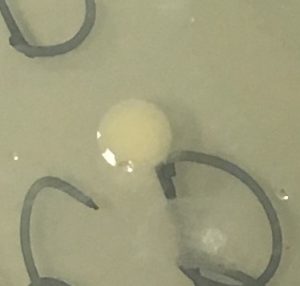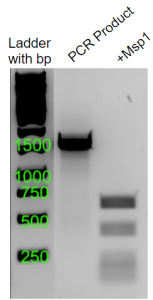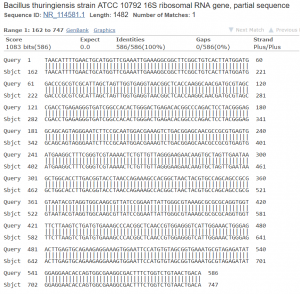Bacillus thuringiensis is a gram-positive bacteria that forms spores that crystalize into parasporal proteins during its growth. B. thuringiensis was isolated from silkworms in Japan by Shigetane Ishiwata, a Japanese scientist, in 1901. Also, Schnepf and colleagues (1998) isolated B. thuringiensis from many different habitats around the world, some of which include soils, dusts, and leaf litter from deciduous and coniferous trees.
References:
- Schnepf E, Crickmore N, Van Rie J, Lereclus D, Baum J, Feitelson J, Zeigler DR, Dean DH. 1998. Bacillus thuringiensis and its pesticidal crystal proteins. Amer Society of Microbiol. 63(3):775-806.
- Ibrahim MA, Griko N, Junker M, Bulla LA. 2010. Bacillus thuringiensis a genomics and proteomics perspective. Bioeng Bugs. 1(1):31-50.
Date collected: February 9, 2017
Methods for isolation and identification:
- Fifty milliliters of a soil sample was collected from the submerged soil beneath the water of a section of Buffalo Creek at Lancer Park (Figure 1). This sample was 10 centimeters deep. A sterilized swab was placed in the water and used to spread the sample across a sterile LB agar plate. The plate was incubated at 20 degrees Celsius for 96 hours.
- A light yellow/creamed colored colony (Figure 2) was used for PCR amplification for 16S rRNA gene sequencing.
- The PCR product was sequenced to identify the genus and species of the bacteria present in the sample and was digested with Msp1.

Figure 1. Site of collection

Figure 2. Colony selected for identification
Results:
- MspI digestion (Figure 3): A 1,500 bp product was amplified by PCR. Conseuquent to the digestion with MspI, four bands at approximately 600 bp, 400 bp, 200 bp, and 150 bp were identified.

Figure 3. Results of PCR amplification and MspI digestion
- Sequence analysis (Figure 4): The PCR product that was sequenced produced 586 bases of high-quality reads that were used to identify the genus and species of the colony. The chromatogram of the sequence is available as a media file upload located in the media section (9B_PREMIX_JF7516_12). NCBI BLAST analysis revealed 100% identity with bases 162-747 of the 16s rRNA gene of Bacillus thuringiensis (Figure 4).

Figure 4. NCBI BLAST analysis of colony 9B
Contributed by: Juliana R. Gordon, BIOL 250 Spring 2017, Group 9B